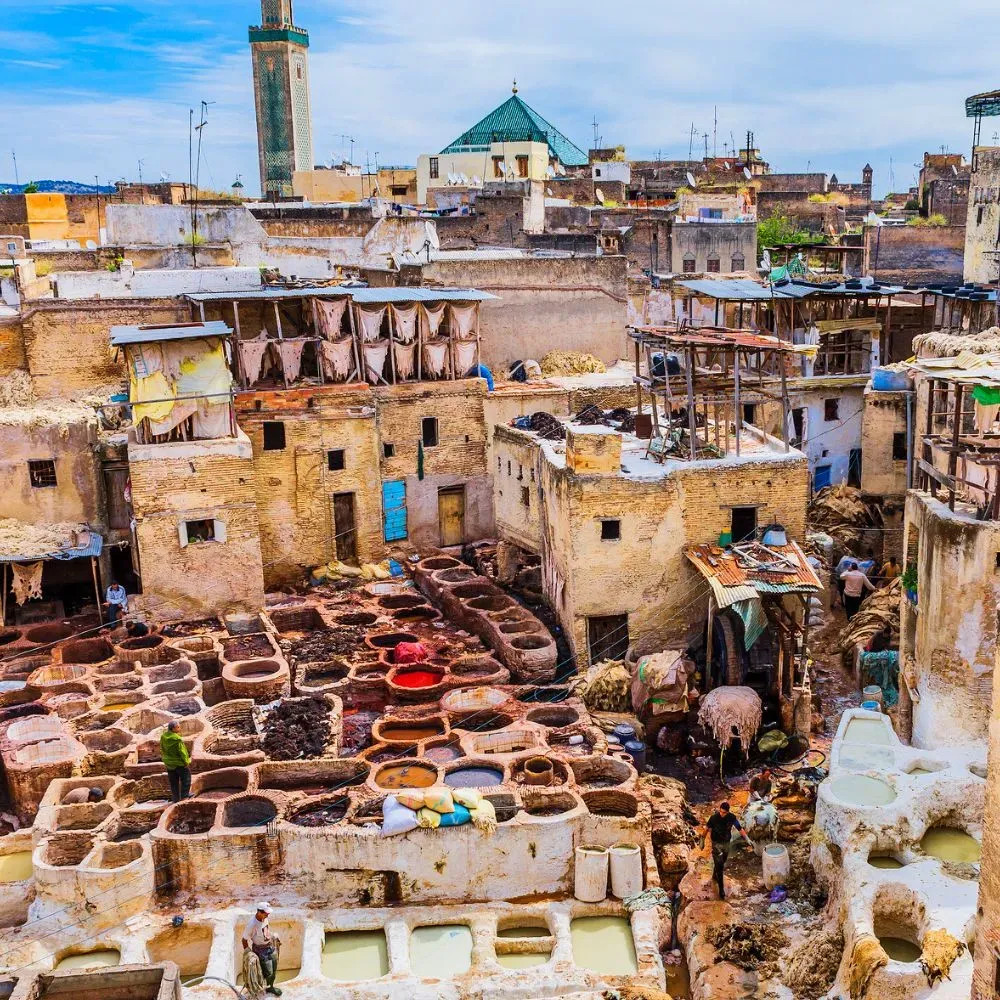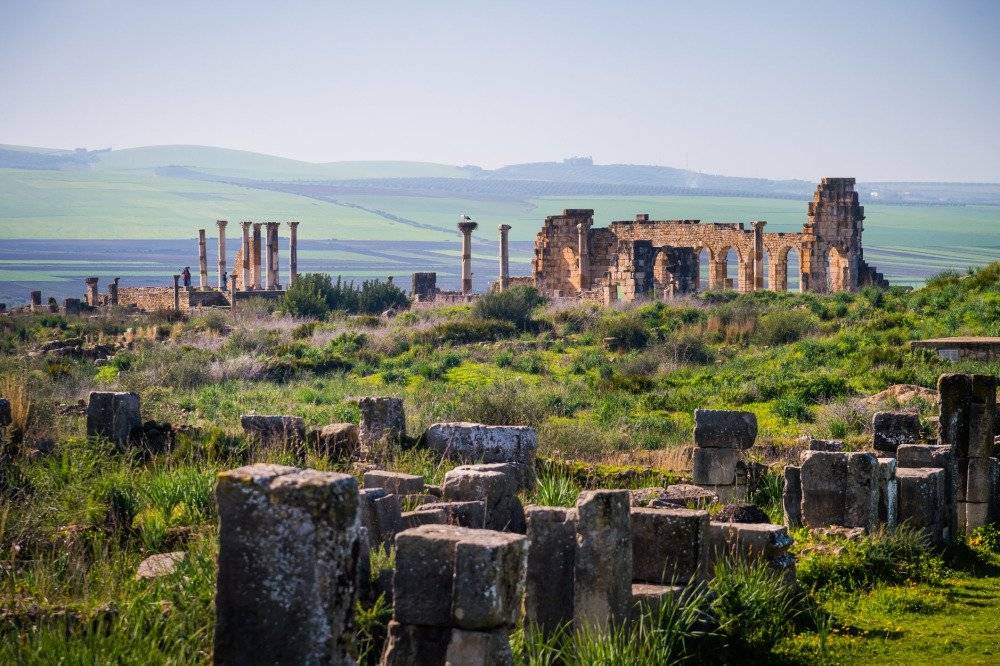Unless you’re an alcoholic, Morocco is a wonderful country to visit, with a fascinating landscape, stunning historic architecture, sweeping deserts and great beaches. Its largest city, Casablanca, is an exciting metropolis, especially if you’re driving in it, with cars coming within millimeters of each other as they jockey for position in the near-gridlock traffic jams; Marrakech is a treasure chest of spectacular mosques, palaces and gardens; and Tangier is a captivating port with beaches on both the Atlantic and the Mediterranean.
But my favorite place in the country is Fes (aka Fez), and not only because it’s less visited by tourists than other places in the country and is therefore more affordable. Its 1200-year-old walled medina is one of the most fascinating places I have ever experienced. It has exactly 9,454 alleyways and about 300 mosques and is the world’s largest living medieval Islamic city – as well as the world’s largest pedestrian zone.
The Riad I stayed in was not far from the Bab Shorfa gate, one of several such entrances to the medina. Having heard that it was impossible not to get lost in the medina, my companion and I decided, on the first day, that we would explore it without a map and that we would not get lost. Long story short, we got lost and couldn’t find our way back to the gate through which we had entered.
We ended up on a small square with a fountain at its center on the edge of which a few boys were sitting. I told one of the boys, in French, that we were lost and tried to explain the location of the gate through which we had come.
“I know where that is,” he said. “I can take you there.”
I asked him how much it would cost me. “Only the price of a cup of coffee,” he replied.
Off we set. I realized later that he had taken us on a very roundabout route, because it took about 45 minutes to get back to the Bab Shorfa gate, when it should have taken less than half that time. When we finally emerged from the maze, I gave the boy what I thought was enough of a tip. But he gave me a reproachful look.
“What’s the matter?” I said. “You said the price was a cup of coffee.”
“Yes,” he replied. “But I drink very good coffee.”
After I stopped laughing, I gave him what he wanted, not for his work as a guide but for his cheekiness. Moroccans are generally very friendly and eager to help, and not only for cash. And it always helps if you speak at least a little French.
How to Get There
There are cheap direct flights from most European capitals to Fes, especially inexpensive in the off-season, which – happily – is the best time to go. If your city doesn’t offer direct flights, you will have a layover probably in Lisbon, which adds about 10 hours to the flight time, but gives you the chance to have a look at another wonderful city.
Where to Stay
At a Riad or Dar, definitely. These are old homes that have been transformed into a bed and breakfast or a boutique hotel. They are usually beautifully decorated in the traditional Moroccan style and often located in or near the medina. The difference between the two is that a Riad is larger and often has a small garden.
What to See
The Fes El Bali medina is endlessly fascinating, with its many souks (markets), mosques and old madrasas and the many twisting paths that can lead you in a circle. But getting lost has always been one of my favorite ways to get to know a place.
The oldest existing and continually operating educational institution in the world is in the medina. The University of al-Qarawiyyin was founded in the year 859. The famed Jewish philosopher Maimonides taught there for a few years.
The Chouarra Tannery is a must experience. You walk up some stairs and come out above the many dye pots, which will dazzle your eyes with colors. You can follow the entire process from hide to finished product, and in the end you can, if you wish, buy a leather product that is well made and, for genuine leather, relatively inexpensive.
I have used and abused the sturdy leather travel bag I bought there for nine years and it still looks the way it did when I bought it. So check out some of the nearby leather shops. Some local ‘guides’ will want to lead you to a specific shop. Ignore them. They usually get a kickback from the shop that will increase the price of whatever you purchase there.
The Jnan Sbil Gardens is a great place to take a break from the sometimes claustrophobic – there are alleys so narrow you have to walk sideways – bustle of the medina. It has colorful fountains, calming lakes and ponds and some 3,000 species of plants. Go in late afternoon, when it’s cool and the locals come there to relax.
The Al-Attarine Madrasa was built in the early 14th century and is one of the loveliest buildings in the city. The nearby Tala’a Kebira is one of the most important streets in the medina as it is the main market street of Fes. On it is the Souq al-‘Attarine, the former Spice Market, which now sells a large variety of items.
The Bou Inania Madrasa also stems from the 14th century and, unlike other madrasas, is open to the public. It is out-and-out beautiful and considered a marvel of Moroccan architecture.
The Royal Palace is not, strictly speaking, in the old medina. It was built in what is called “New Fes,” which was regarded at the time as an extension of the medina. It was once the seat of Morocco’s government and the king occasionally still stays there, so visits are not possible. But go see it anyway.
Definitely frequent any rooftop café you can find. The buildings in Fes have flat roofs so there are quite a few places where you can rest your aching feet and enjoy a (non-alcoholic) drink – mint tea is recommended – while you watch the sunset.
Eating in Fes
The medina is a veritable gold mine of local street food. Here are a few to try:
Msemen are square pancakes you can enjoy with butter and honey or with tomatoes, olives and onion. They typically cost around 1 euro.
Pastilla is a delicious combination of chicken, cinnamon and crushed almonds and topped with – wait for it – sugar and honey. Definitely try it if you’re not a vegetarian. You can easily find it in restaurants for as little as 5 euro.
Bissara is a scrumptious fava bean soup that costs around 2-3 euro. Safe to say vegetarians should literally eat this up.
And for dessert, try the very sweet chebakia, which is made from deep-fried strips of dough and coated with a honey, orange blossom syrup and sesame. I’ve found it on the streets of Fes for as little as 1 euro. My sweet taste buds are tingling just thinking about it.
The Tajine
If, for some reason, you already don’t know what a tajine is, this will be your opportunity to become acquainted with one of the world’s great dishes. The dish gets its name from the conical earthenware pot in which it is cooked. There are several types of tajines in North Africa.
The type served in Morocco (and also in Algeria) is a slow-cooked stew made with sliced lamb, chicken or fish, vegetables and/or fruit and a variety of wonderful spices, such as ginger, turmeric, cumin, cinnamon, saffron and chili. A lamb tajine is often cooked with prunes and spices and costs around 7 euro. I love tajines and often cook them at home (in fact, one is stewing on my stove as we speak). Definitely have at least one to see what all my fuss is about.
If you’ve had tajines in a restaurant in the U.S. or Europe, you probably had it served over couscous (couscous is a different dish in Morocco, and also very good). In Morocco, a tajine is generally served with bread and sometimes with a side of harissa, a spicy paste that can be added to whatever you’re eating. Add a little at a time, because it can be very hot, depending on the chef’s recipe.
Harira is another Moroccan dish I love. This is a brawny tomato-based soup with chickpeas, lentils and beef, lamb, or chicken, seasoned with some of the spices used in a tajine. It’s often eaten during Ramadan to break the fast and restore the strength of those who fasted. There are vegetarian versions of both harira and tajine, and they are just as delicious as those with meat. You can find them in any restaurant, setting you back around 2-3 euro.
My favorite of the numerous restaurants in the medina is the Café Restaurant Al Oud. It serves wonderful tajines as well as other typical Moroccan dishes. The service is great and the prices are more than correct. But it’s small, so reserve.
NB: As I suggested at the beginning, Morocco is not for boozers, as the consumption of alcohol is forbidden to Muslims, and the population is 99% Shia Muslim. But if you must have red wine with your meal, be aware that almost no restaurants in Fes serves wine, but some allow you to bring your own.
Finding Wine in Morocco
This leaves you with the problem of buying a bottle of wine. I found my wine in a Carrefour supermarket. Carrefour is a French chain and there are at least three Carrefours in Fes, but they are all discreet when it comes to wine. The one I visited sold its wines in a small room in the basement, as far away from the main shopping area as possible. There were no signs for it; I had to ask an employee how to find it.
After purchase, with my bottle well-concealed in a shopping bag, we were not allowed to return to the main store but had to leave by a back door, like sinners. Then came the problem of finding a place to buy a corkscrew. It took another hour to find a store that carried them.
You get the idea. It’s probably not worth it if you can take wine or leave it. If not, ask around about restaurants that do serve wine or bring your own corkscrew and find a Carrefour.
The Ruins of Volubilis
About 60km (37 miles) from Fes stand the ruins of the Roman city of Volubilis, which was an important outpost some 2,000 years ago. At its height, the city had a population of about 20,000 and was a center of trade and olive oil production. Major monuments were constructed, such as temples, major civic buildings, baths and an aqueduct to feed the baths.
However, after the Romans left, the city deteriorated and many buildings were left to fall apart. Then, sometime in the fifth century, an earthquake destroyed most of what was still standing and covered, and therefore preserved, many bronze statues, some of which can be seen in the on-site museum.
Archeological work carried out in the first half of the 20th century restored the place to what you see today. Especially look for the many gorgeous mosaics.
How to get there: The best way is to hire a car in Fes. The round trip is not expensive and well worth it. Agree on a price and a time schedule with the driver before you get in the car. It’s a pleasant trip through the Moroccan countryside, and you will pass one of the king’s private gardens. When I was there, water rationing was in effect due to a serious drought. But the fountains and sprinklers were working overtime in the lush gardens. It must be great to be a king.
And while you’re in Volubilis, you may want to have a look at nearby (3 km away) Moulay Idriss Zerhoun, one of the holiest places in Morocco. Moulay Idris Al Akbar was the great-grandson of the Prophet Muhammad and settled in Moulay in the late 8th century. The site is considered so sacred that, according to legend, five trips to Moulay Idriss during one lifetime can equal a trip to Mecca.
Definitely visit the tomb of Moulay Idriss. While only Muslims are allowed to enter the site, it offers spectacular views of the valleys below. Decide before you leave Fes if you want to see the town, so you can agree on the price with your driver.
Finally
By all means, go to Marrakesh or Rabat or whatever place you have set your heart on in Morocco. But do yourself a favor and don’t pass Fes by. Spend a few days exploring the medina and the rest of this unique city. From the song of the muezzin in the morning, calling the devout to prayer, and the sight of the donkeys used to carry the trash plucked off the narrow streets in fancy saddlebags, to the aroma of the spices and the odor of the leather in the tanneries, it is an experience that is both sensual and eye-opening. And it has a certain, special feel to it that I can’t put into words but has made the three days I spent there remain very clear in my mind.










